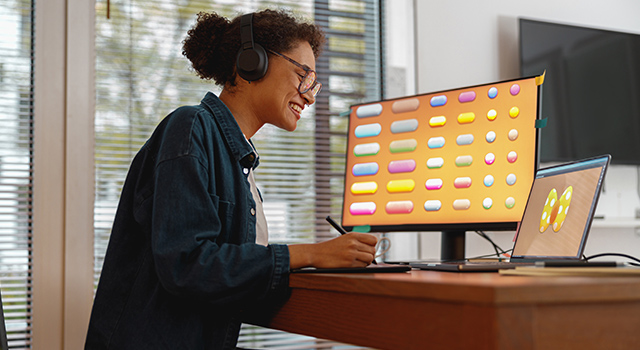When it comes to crafting exceptional designs, we’re often asked which is better – PC or Mac? There’s a deep-seeded belief Apple’s iMac/MacBook has a leg up on the more business-oriented PC, but the truth may be a bit more subjective.
As far as software goes, there isn’t a difference between how most graphic design software operates on a Mac versus a PC. Both have their own functionality, awesome shortcuts, and frustrating shortcomings.
In the realm of real-world application, if the final files are capable of being printed, or being uploaded properly, it shouldn’t matter which operating system your designers use. If you’re in a business that wants to maintain consistency, this could be great news for you.
However, it’s also wise to consider the graphics designer you’ve hired and what they’re most comfortable with as well. As with most things in life, when you’re comfortable with something, you proceed with confidence. This often translates into faster turnaround times and less lag due to the learning (or unlearning/relearning, as we’ll discuss below) curve.
Since there are plenty of pros and cons to consider with both Mac-based computers and PCs, let’s dig in to have a closer look:
Mac Strengths
It’s all in the beginning – For most designers, working with a Mac starts as early as a design school. Colleges across the country start new designers with a MacBook and the software programs needed to do their jobs best. This in turn suggests it’s going to be easier for many designers to “stick with what they know” over having to unlearn and relearn how to do their job.
Tech whizzes we are not – In addition to the way most designers start, not every designer is a tech guru. In fact, many like to stick with what they already know. Of course, there’s always the exception to the rule.
Keep it simple – From their terrific graphics, font capabilities, and ease of use, Mac-based machines have been a step ahead of the game. Particularly for designers who want to focus on their task at hand without over complicating the design process.
We like quality – As far as the hardware goes, while Mac-based computers are known to be more expensive—they’re also known to last. Over the past twenty or so years, there have been no major recall issues, and they’re not prone to hardware failure.
Cloud connectivity rocks – We’ve officially entered the Cloud Age, and with it, we’ve been bestowed the gift of designing on the fly. This can mean working on your iMac at work, then picking it back up on your iPad or even iPhone from home. Both Apple and Adobe have made this process practically seamless. While Microsoft and Android users are now able to access some of the Adobe Creative Cloud Suite, not all apps are available to the same degree as Apple users.
Who can forget style? – Of course, designers love the design. They love the look and feel of the things. So, it should come as no surprise that they like the visual style of a Mac over a PC. Okay, we admit this one may be a bit superfluous, but it still goes in the pro column.
Mac Weaknesses
Ouch, cost – Mac’s biggest weakness typically comes in the form of cost. Many individuals and businesses simply can’t justify the price hike by the popular computing system.
Who knows how to use this? – While Mac-based computers are known to be less complicated and have fewer issues, they can still happen from time to time. A printer doesn’t connect, or the Wi-Fi is acting screwy. When the rest of a company has PCs, and the IT department has never had to work on your Mac, it can mean considerable wait times to research and implement the solution.
PC Strengths
One IT guy to rule them all – For a lot of businesses having a standard computing platform for the business is important. They want the ease of compatibility without having to hire an IT person who knows the ins and outs of both a Mac and PC. So, while more designers themselves may prefer the Mac experience, not all businesses want to break ranks for just a couple people on their design team. If this sounds like your company, you’ll be happy to know the operating system doesn’t matter in the grand scheme of things. Many great designers can and do create amazing pieces using a PC every day.
Choice, choices – There happens to be a lot more software available for PCs than there are Mac-based computers. Apple has a rigorous approval process, while PCs are more of open-source. This plays out in more choice. Particularly if you’re in need of design software that focuses on a specific industry, renders 3-D models, and wanting intricate gaming design.
I need more power – Most PCs that aren’t ancient will likely to have more power than a Mac built at the same time. Whether its memory, graphics capabilities, or overall hard drive speeds and storage, you’ll get more for your money with a PC.
PC Weaknesses
Perceptions – PCs have the reputation to be “stuffy” and “boring.” For the younger generation of Millennial designers, this does play on their minds. While things have changed a lot in the capabilities between both, the old mentality still lingers. In fact, I bet everyone is reading this still remembers the popular commercials “I’m a Mac/I’m a PC.” They were wildly popular because they drove home the stereotype.
Cheaper isn’t always better – One word of caution, though. While PCs are cheaper, so can be the durability of their components. PCs do tend to have more hardware issues than a Mac, which can cause considerable downtime when these issues arise.
Conclusion
Ultimately, the preference between Mac and PC comes down to the designer and what they’re comfortable with; along with the industry they’re designing for. While Mac-based computers have been known industry-wide to be the choice for designers, there are plenty who like the open versatility that PCs bring. Determining your company’s use and the designers you have on board can help guide you to the right purchase for your team.
– Artwork Abode




